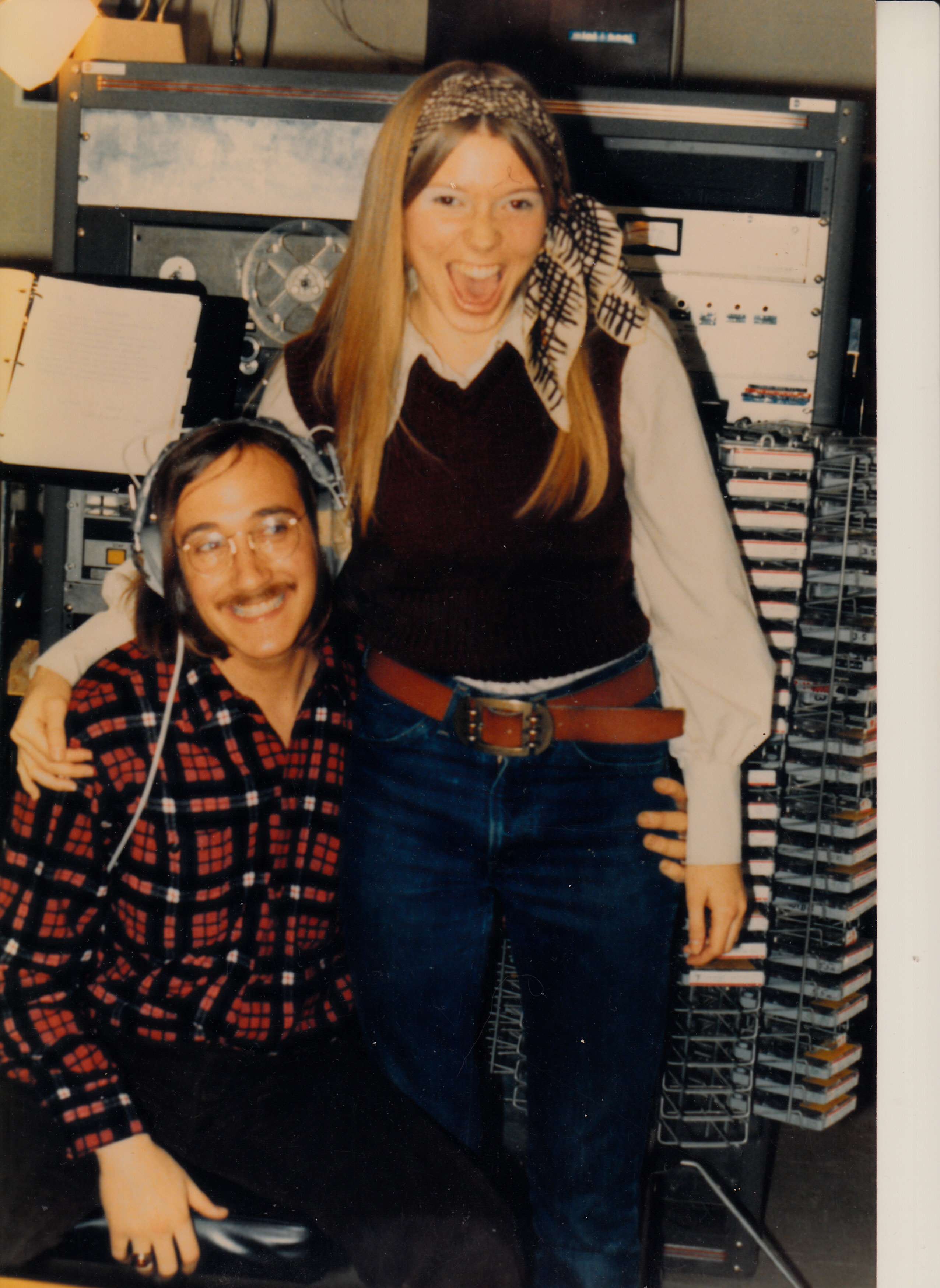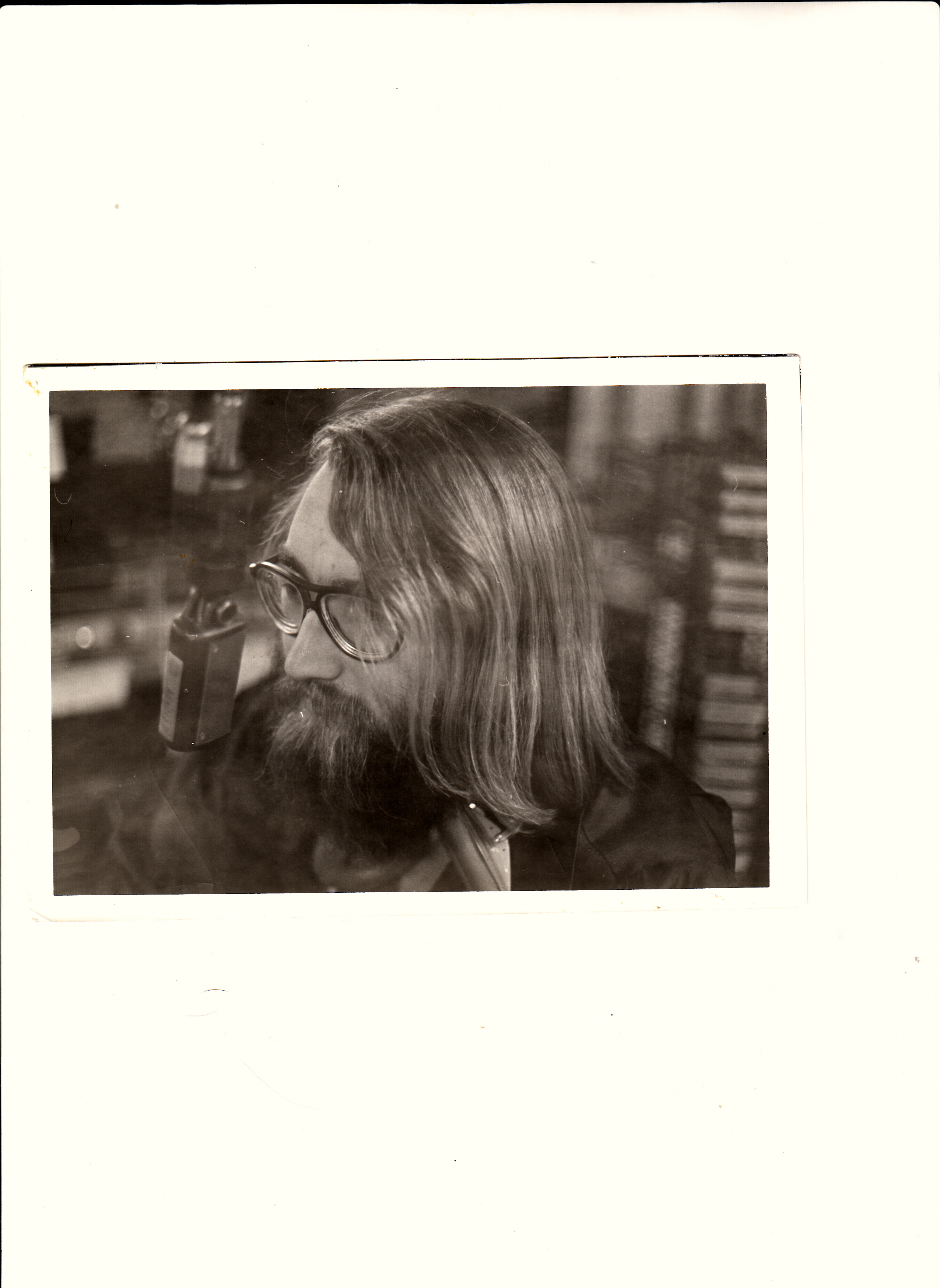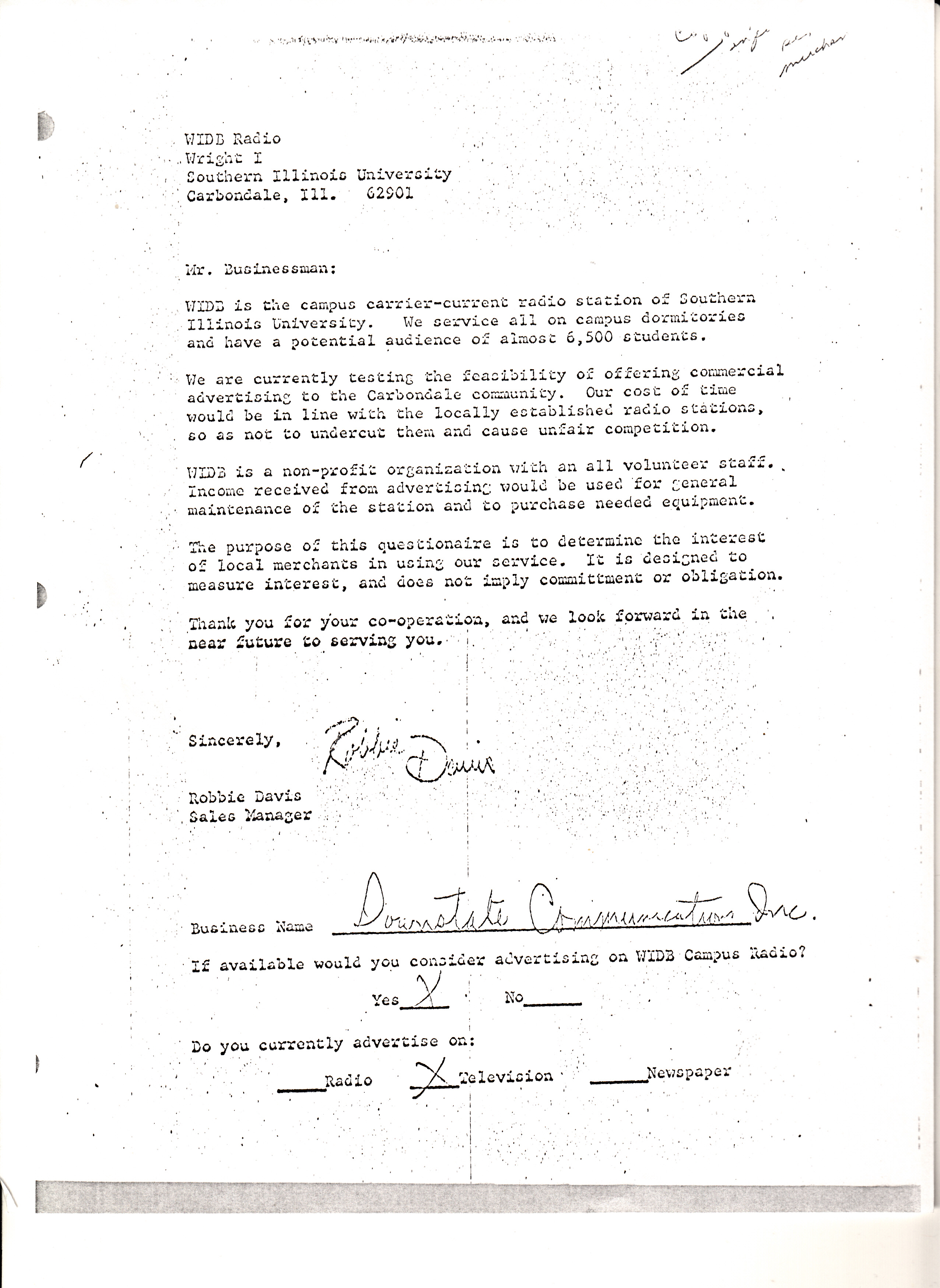CHAPTER 13
THERE’S A STATION TO RUN–REMEMBER?
Meanwhile, there was still college to attend and a station to run. Fall quarter began September 22, 1971 and while it was disappointing that WIDB could not sell advertising, the show had to go on. Someone had to be at the station in the morning to open it up and sign on. Every 3-hour shift was supposed to have a jock, board operator and a newsperson. There had to be a playlist with records set out for airplay. The jingles and produced IDs, promos, and other items had to be ready. And all of this was to be ready and rolling BEFORE the dorms opened.
Tom Scheithe was Program Director. Jim Hoffman had left as Music Director and there was no replacement, so Tom had to do that too. Sam Glick was Operations Director, which meant he had to audition, approve, and schedule jocks. No one was serving as News Director. John Melin was Chief Engineer, and one of his duties was to recruit, train and schedule board operators, Jim Rohr was Public Relations Director, Pat Becker was Office Manager.
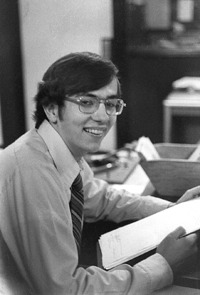
Tom Scheithe, Program Director 71-2, WIDB founding member, also worked at WLTL (Schneider pirate station).
Somehow, Tom got the station up and running by September 20. It was a Top-40 format with jingles, with “underground” most nights and “Pillowtalk” on weekend nights. News was supposed to be every hour, but there was no UPI (teletype) machine, so, if anyone showed up to do news, stories had to be read from newspapers or SIU press releases.
New students made a beeline to WIDB and started filling shifts. Gary West did 14 newscasts on September 20. Justin Case came from Louisville and was installed as a 7-10pm jock. Harry Staffileno and Jim Alchenberger were his board operators. Luther Thompson briefly tried that slot, but was replaced by Ed Clanton (Brother EC). So Justin Case and Brother EC alternated evenings, during highest listenership. Kevin J. Potts, Dennis Lyle, and Todd Cave all got midday slots. Other new persons included newspeople Katie O’Neill, Don Graf, Phil Cline, and engineers Ed Kasovic and Phil Hejtmanek.
Returning jocks included Roger (“Ramjet”) Davis, Robbie Davis, Mike Murphy, Keith Weinman, Sam, Tom, even Joel, Jim Walsh, Woody Mosgers, underground jocks Harvey (Michaels) Welstein, David R. Eads, Clyde Swanson, Pillowtalk Susie Meyers (“Stacey Brennan”) and Kay Kessler (“Jennifer”), and board operators Jim Alchenberger, Dave Silver, Craig Hunsley, and newsmen Pete Jaegar and the legendary Allan J,. Friedman. Many jocks such as Roger, Todd, Dennis, Keith and others also did news and sports. Here is an edited “slice of life” to show how WIDB sounded Fall 71.
The station quickly became a hotbed of activity. Keep in mind that the station had only the “studio” space (activity room) on only one side of Wright I and there were no “offices across the hall.” Plus, there was always a jock in one studio, a newsman in the other, a board op in master control and a couple people in the production room and everyone else in the “main” room, (where the water fountain was), Next to the mailboxes for staff heads were the three weekly schedules: Jocks, News, Board Ops. There were 3 desks and at least 3 multi-line phones in the main room, but maybe 3 chairs. If you wanted to hang out, you had to stand or maybe sit on desk. Some people had 3 or more shifts each week and still hung out for more time, just in case something came up to do.
Meanwhile, at the high levels of WIDB administration, Charlie had left somewhat abruptly in June and placed his friend Bob Huntington in charge, but Bob left for the summer. Bob had been Chief Engineer after Dan left in February. But Joel had been summer GM, gotten caught up in the effort to get advertising and Joel had exhibited some major leadership qualities which greatly impressed Tom and Robbie.
There was no UPI machine for news and the Board needed to authorize payment to UPI so news could be broadcast on WIDB. Some wanted to spend the money on a “Field Strength Meter” which would be used to see if WIDB’s signal radiated beyond the dorms. But if the FSM was purchased there would be no news, maybe for the rest of the year. Frank Mazzocco was ready to become news director, but he demanded that the UPI be funded first. (Remember the priority news had had during the war, riots, draft, etc.) Tom was a board member since he was Program Director, and he was in favor of UPI. The board voted to fund UPI. Frank became news director, and was one of the best WIDB ever had at an important time for news. WIDB became the “go-to” news and information source for most students, and this never would have happened if not the UPI and Frank.
Meanwhile Joel, Robbie, Sam, Tom, and Pat wanted to push forward with the sales proposal. Joel and Robbie decided to “survey” Carbondale merchants to see if they would advertise on WIDB and if so, would that divert money they were already spending for advertising elsewhere. So one Saturday morning in early October Joel, Pat and Robbie appeared dressed up at the station and prepared to “cold call” the merchants. In some cases, surveys were left and returned by mail.
At a WIDB Board meeting October 14, 1971, it was agreed that a new position would be created, that of “Station Manager”, officially an assistant to the GM. But everyone knew Bob was done and Joel was in charge. As Station Manager, Joel could officially represent the station to others as well as lead from within. Bob left officially a few months later and Joel officially became GM. There was no need for a Station Manager now. But there was no bad blood between Bob and Joel. They started a company together, “New Dimensions Media,” which, by the following spring, had the first telephone answering machine in Southern Illinois.
Meanwhile, station programming was improving and becoming more consistent. Shifts were filled, even news. The talk show Anodyne (on Monday evenings) was usually hosted by Bob and featured guests with involvement in students, such as Dean Justice (who booked acts like the Carpenters and “Up with People” at the Arena), and Brooks High, an executive with General Telephone Company, which controlled all telephones in Carbondale at that time. (There had been dial service in Carbondale less than 10 years and touch tone service was still years away.) Bob snagged an interview with Bill Chase and his group after they played the Arena. The Carpenters played the Arena for Homecoming, but no one at the station brought them over for interviews.
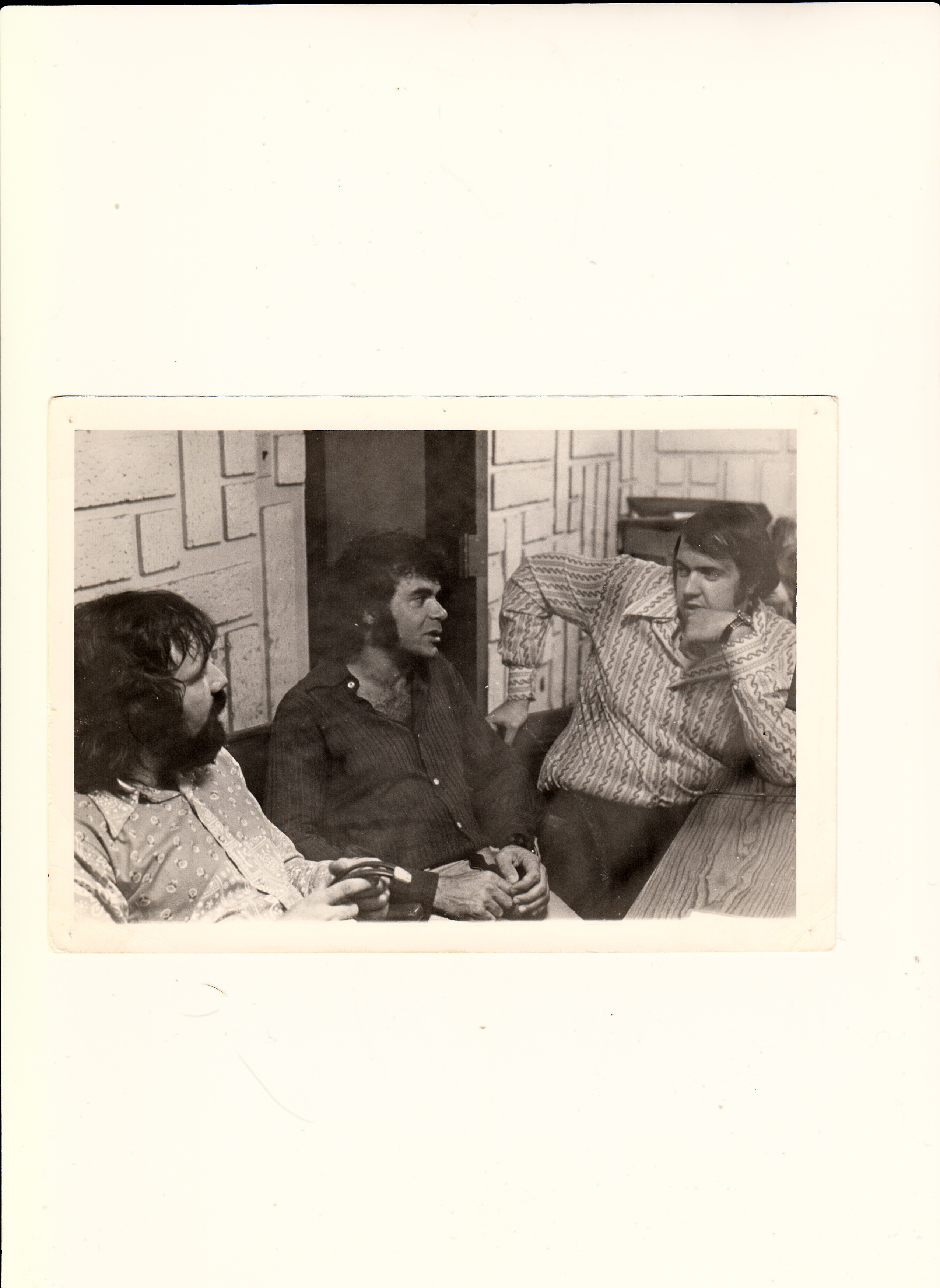
At WIDB Bob Huntington interviews Bill Chase & group after their performance in the SIU Arena, fall, 1971 (audio excerpt below)
Wally Wawro became music director. The station remained top 40 with jingles, and the famous ID “WIDB…Carbondale…is…together” was over top songs every hour during top 40. Here is a playlist from that time of the Roger Ramjet show:
Here is a “slice of life” from a Roger Ramjet show. He did a six-hour shift each Sunday.
In addition to Pillowtalk, underground and Anodyne, there was one other specialty show. Rob “Ol’ Blood” White had demanded programming for Blacks the year before and Howie gave him a show, But now Rob was gone and in his place came Leo Knott (The Dynamic LTL). Leo needed an engineer (board operator) and everybody knew nobody listened to the “soul show,” especially since it was on Friday 10pm-1am. Nobody wanted to engineer the show. So it fell to the youngest and newest engineer, who could not refuse the assignment. Just like Tom Sawyer painting the fence, this shift became the most coveted in the station. By spring, many were begging to do the show.
The main reason was Leo. He was very personable, charming, engaging and positive. He voluntarily promoted the rest of the station on his show. He complimented listeners who called in and made requests. He told jokes that were actually funny. He provided “features” such as “Black News” and “Yesterday in Afro-American History” (which were articles read from Jet magazine). He played music that everyone liked (much of soul music was mainstream then, such as Jackson 5, Four Tops, 5th Dimension, Bill Withers, Chi-lites, etc.)
Leo’s engineer was a 17-year-old freshman, who liked soul music, could run a “tight board,” and had some production skills. Taking a cue from Tom Scheithe’s “hatchet job” on the “Beat Goes On” jingles for WIDB’s Top-40 format, Leo’s engineer found useful jingles from Chicago’s main black radio station, WVON. Cutting out the call letters, Leo’s engineer created useful “Soulful Weekend,” “More Soul Power” and “Soul City” jingles, as well as ID’s and exits for the features.
It had been expected that only Black students would be listening, if anyone was. But by November, lots of others were listening too. There were requests for particular jingles. There were calls from dorm rooms that were crowded with people all listening to the WIDB Soul Show with the Dynamic LTL.
Leo’s engineer was Gary West. “We seemed to have a special bond. We each had skills that complimented the other. It was exciting to produce jingles and get compliments. It was exciting to run a “tight board” and people would recognize this. Leo would be tight I would be tight, we were all learning and improving, and so many people enjoyed the show every week.”
Here is an edited slice of life from the Dynamic LTL Soul Show. Listen to how engaging Leo is, mentioning callers, complementing other station members coming to visit at 1 am Wednesday.
But part of the Soul Show discussed controversial issues. When Tom Scheithe chose Leo, Tom realized Leo was not the personality to address controversial issues (and there were plenty at that time, racial and otherwise). So Tom decided that 30 minutes of Leo’s show would be a “Black Talk/Black News” show within a show. Tom selected Ken Davis for this part of the show.
No one at WIDB was sure what to make of Ken Davis. He didn’t talk much to anyone on the staff, even Leo. He just came and did his show. In hindsight, he did seem to make a good-faith effort to deal with the issues of the day (which is the main purpose of radio). And like the rest of us, he was young and he was learning too.
One Friday in the fall of 71, Ken decided to address interracial dating on his show. By then he was calling himself “K-Rap” and he was calling his portion of the show the “K-Rap Rap Line, the show for you, you the people.” K-Rap decided to take phone calls from listeners and air them without screening the calls. There was no delay system, despite repeated begging from the engineer. K-Rap decided to get things going by announcing that he had no interest in dating any Black girls since “they have too many diseases.” The phones lit up and there were more than several expletives aired. Luckily the engineer recorded the show. Here is an excerpt:
The next week the engineer discussed the show with Tom:
ENGINEER: Say Tom, by any chance, did you happen to listen to the Soul Show Friday?
TOM: No, why, should I have?
ENGINEER: Uh, you might want to listen to the “K-Rap” portion. You may want to take some action. Here’s the tape.
All of this only increased interest in the Soul Show. It was moved to Tuesdays and given an extra hour (but K-Rap still got only 30 minutes). Even though it was Tuesdays the “Soulful Weekend” jingle remained. By spring, the station became a “social center” during the LTL show, with other WIDB jocks and even the Student Body President coming down to hang at 1am Wednesday.

